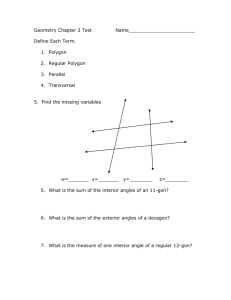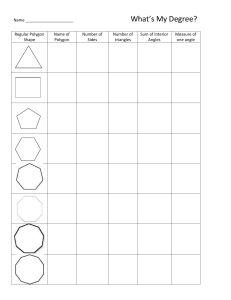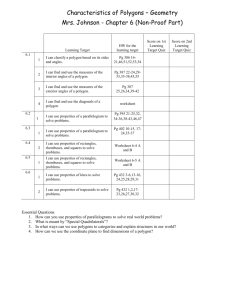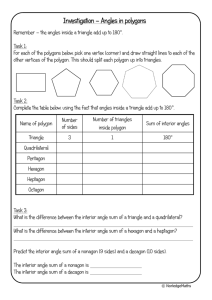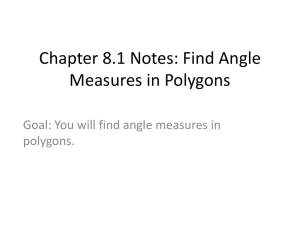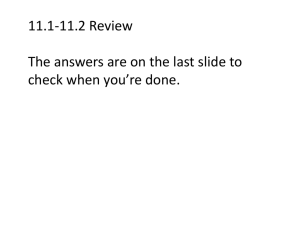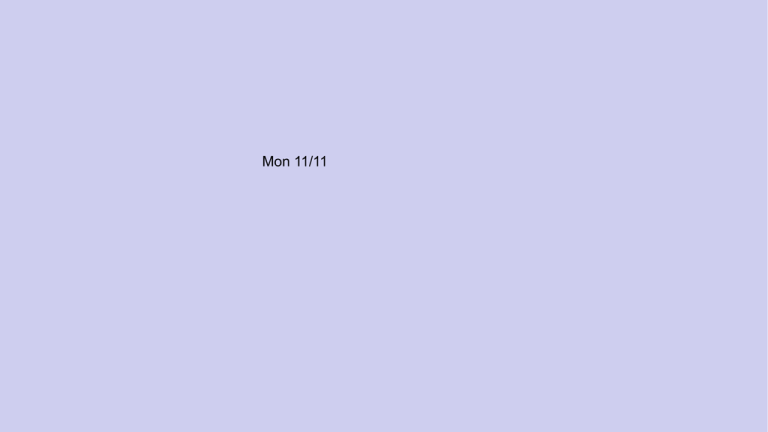
Mon 11/11
Boot-Up
11.11.13 / 6 min.
Solve for all variables shown:
1st Time
2nd Time
Chapter 5 Test
Chapter 4 Test
72
Chapter 4 Quiz
91
Term 1 Test
Ch 3 Test
90
Ch 3 Section 1 Quiz
80 82
Ch 2 Test
60
74
Ch 2 Sec 1 Quiz Angles
82
Ch 1 Test Symmetry, Transformations,
P&P Lines, P&A Zoom, Angles
70
Ch 1 Quiz Algebra Review & 1.1.3
Perimeter/Area
80
YTD Average
100
Block 1 Test Performance: Class Averages / Term 1
86 86 90
85
78
50
40
30
20
10
0
Chapter 5 11/1 Test Performance: Block 1
12
48%
60%
10
8
6
4
2
50%
11
40%
26%
30%
6
20%
9%
9%
9%
2
2
2
0
10%
0%
Series1
Series2
1st Time
2nd Time
89
Chapter 5 Test
79 84
Chapter 4 Test
72
75
Chapter 4 Quiz
89
Term 1 Test
Ch 3 Test
90
Ch 3 Section 1 Quiz
70
82
Ch 2 Test
60
78
Ch 2 Sec 1 Quiz Angles
80
Ch 1 Test Symmetry, Transformations,
P&P Lines, P&A Zoom, Angles
70
Ch 1 Quiz Algebra Review & 1.1.3
Perimeter/Area
80
YTD Average
Block 2 Test Performance: Class Averages / Term 1
100
79
50
40
30
20
10
0
Chapter 5 11/1 Performance: Block 2
9
8
7
31%
8
35%
30%
23%
25%
6
6
5
4
15%
4
3
15%
4
15%
4
20%
15%
10%
2
5%
1
0
0%
A
B
C
Series1
D
Series2
F
1. TRIG RATIOS
2.
3. MAKING CONNECTIONS
Tue 11/12
In the figure at right, line m is
parallel to line n, and line t is a
transversal crossing both m & n.
Which of the following lists has 3
angles that are all equal in
measure?
A. ∠a, ∠b, ∠d B. ∠a, ∠c, ∠d
C. ∠a, ∠c, ∠e D. ∠b, ∠c, ∠d
E. ∠b, ∠c, ∠e
© 2004 ACT, Inc. All rights reserved.
Wed 11/13
As shown in the figure at right,
ΔABC is isosceles with the length
of AB equal to the length of AC.
Boot-Up
11.13.13 / 6 min.
The measure of ∠A is 40° and
points B, C, and D are collinear.*
What is the measure of ∠ACD ?
A. 70°
B. 80°
C. 110°
D. 140° E. 160°
* All in a straight line.
© 2004 ACT, Inc. All rights reserved.
Find Lesson 8.1.1
8.1.1
8-1
8-2
8-3
8-4
8-5
In this chapter, you will learn:
About special types of Polygons, such as Regular &
non-Convex polygons.
See p.476
How the measures of the interior and exterior angles of a
Regular Polygon are related to the number of sides of the
polygon.
How the areas of similar figures are related.
How to find the area and circumference of a circle and
parts of circles and use this ability to solve problems in
various contexts.
1) TTW: H/O spoons
TSW: Read p.473 Intro paragraph.
8.1.1: SWBAT answer the following ?s:
1) How can I use the # of sides of a
Regular Polygon to find the measure of
Today’s
the central ?
Objective:
2) What type of is needed to form a
Regular Polygon?
3) What is a Convex Polygon?
*SWBAT = Student Will Be Able To
OK, but what’s
in it for me?
If you understand that any problem,
no matter how big or complicated,
and no matter the subject area –
whether academic or real-life – can
be broken down into smaller parts
that you can handle, then that
problem can be solved.
TSW: Read 8-1 1st paragraph.
10 C
20
120u2
120u2
24
12
B
12
180u2
30
A
8-1
1) Can you determine the
measure of any of these s?
2) What kind of shape is being
formed in the center?
3) How many degrees are there
in a circle?
4) Which of these would you call
the central s of the pinwheel?
8-1a
1) What is this polygon called?
8-1b
8-1c TSW close textbook. TTW call & response
Rules for Pinwheels:
1) Corresponding s must be in
corresponding positions.
2) Vertices must meet in center.
3) s must be adjacent to each
other. (No gaps, no overlaps.)
8-2
8-1c TSW close textbook. TTW call & response
Central
1) 1
2) 2
3) 3
# s Used
Pinwheel or
Polygon?
Name of
Shape
Measure of
Central s
8-3
Pinwheels & Polygons: 1-2-3 Angles
Angle 1: 3 s
Angle 2: 9 s
Angle 3: 18 s
Pinwheels & Polygons: A-B-C Angles
Angle A: 8 s
Angle B:
Not a Pinwheel!
Angle C: 5 s
Pinwheels & Polygons: D-E-F Angles
Angle D:
Not a Pinwheel!
Angle E: 12 s
Angle F:
Not a Pinwheel!
8-4a
Thu 11/14
Boot-Up
11.14.13 / 6 min.
What is the area of the shape below?
5
10
Boot-Up
11.14.13 / 6 min.
What is the area of the shape below?
5
10
8.1.1: SWBAT answer the following ?s:
1) How can I use the # of sides of a
Regular Polygon to find the measure of
Today’s
the central ?
Objective:
2) What type of is needed to form a
Regular Polygon?
3) What is a Convex Polygon?
*SWBAT = Student Will Be Able To
Find Problem 8-4c.
8.1.1
8-4c
8-5
8-4c
Convex
Based on what you see, write a
definition for a Convex Polygon.
Non-Convex
Based on what you see, write a definition for a Convex Polygon.
8-4c
Convex Polygon:
The vertices of convex polygons “point outward,” while some of
the vertices of non-convex polygons “point inward.”
8-4c
Pinwheels & Polygons
Angle 1: 3 s
Angle E: 12 s
Which of the below s can be used to build a Convex Polygon?
8-5
TTW H/O Tracing Paper
To build a convex polygon,
you must use s that are:
1) Isosceles
2) Have a central whose
measurement is a factor
(divides evenly into) 360.
Find Lesson 8.1.2
8.1.1
8-13
8-14
8-16
TSW Read 8.1.2 Intro Para
Today’s
Objective:
8.1.2:
SWBAT find the sum of the interior s
of a polygon & will be able to apply
this skill to solve problems.
*SWBAT = Student Will Be Able To
1) What is meant by “interior ?
2) How many interior s are
there?
3) What does each interior
measure?
4) What is the sum of the s?
5) Can you break this shape down into shapes whose
sum you know?
8-13
1) What is the sum of
the s in a ?
2) How many s are
there?
3) What is the sum of all
the s of all 3 s ?
8-13
1) What is meant by
“interior ?
2) How many interior
s are there?
3) What does each
interior measure?
4) What is the sum of
the s?
8-13
1) What does each central
measure?
2) What kind of s are these?
3) If the central measures ___,
& these are ____ s, then what
do the remaining s in the
measure?
8-13
1) How many interior
s are there?
2) What does each
interior measure?
3) What is the sum of
the s?
8-13
# of Triangles
Canst thou determine the formula
to save us from the interminable
torment of these infernal
calculations ere the terrors of
Ragnarok o’ertake us all?
Verily, ‘tis:
(n-2)180
Well done, my
Midgardian friends!
Now to celebrate with
a Frosty Flagon of
Frost-Dragon’s Mead…
8-14b.
Ah! But that ‘tis but the
merest of child’s play for
a true algbebraic warrior
(or geometric giant)!
To prove thy mettle, canst
thou find the sum of the
interior angles of a
100-gon?
Explain your reasoning.
8-14c.
Fri 11/15
The shape shown below is a
Regular Heptagon. What is:
1) The measure of the sum
of all its interior s?
2) The measure of each of
its interior s?
Boot-Up
11.15.13 / 6 min.
a
a
a
a
a
a
a
Today’s
Objective:
8.1.3: SWBAT:
1) Determine the measure of an
interior & exterior of a
Regular Polygon.
*SWBAT = Student Will Be Able To
Find Lesson 8.1.3
8.1.3
8-24
8-25
8-26
8-27
8.1.3
8-36 a,b,d
8-37
8-38
8-24 a, b
Formula to find
measure of each
Interior of a Regular
Polygon, where n = #
sides of polygon.
If it’s a square, then it has 4 equal sides.
If it has 4 equal sides, then it’s a square.
8-25
If it’s a square, then it has 4 right angles.
If it has 4 right angles, then it’s a square.
8-25
8-26a
10
Rectangle
= 30 x 24
= 720
C
20
120u2
120u2
12
24
B
12
180u2
30
A
y
II
I
x
III
IV

